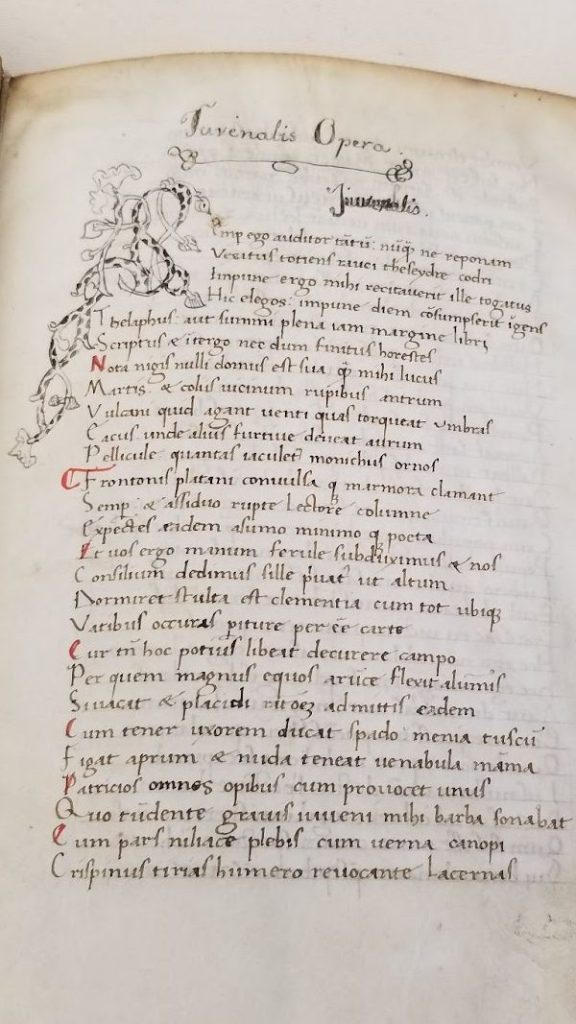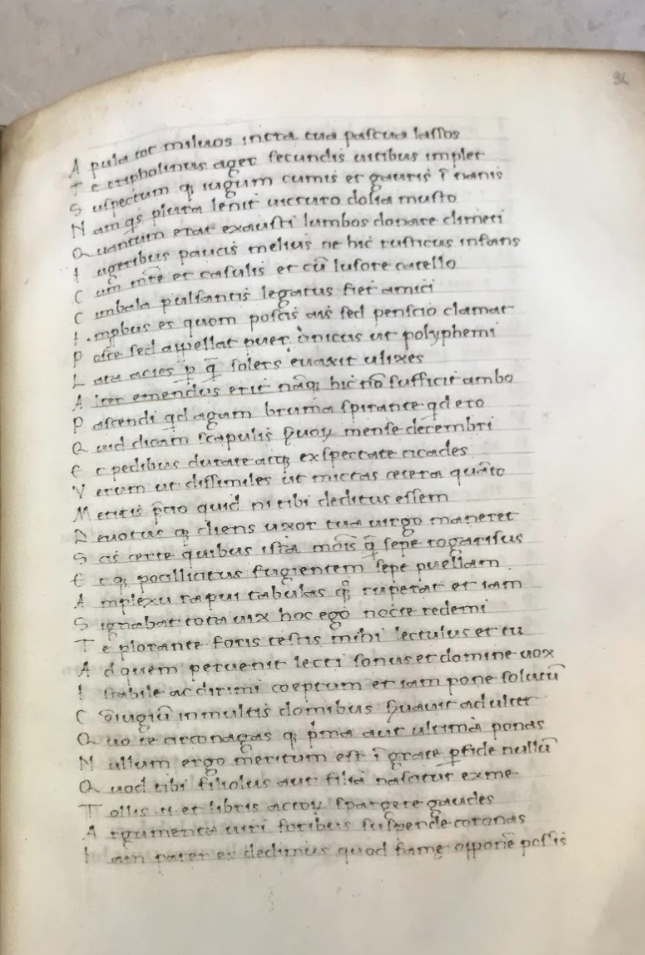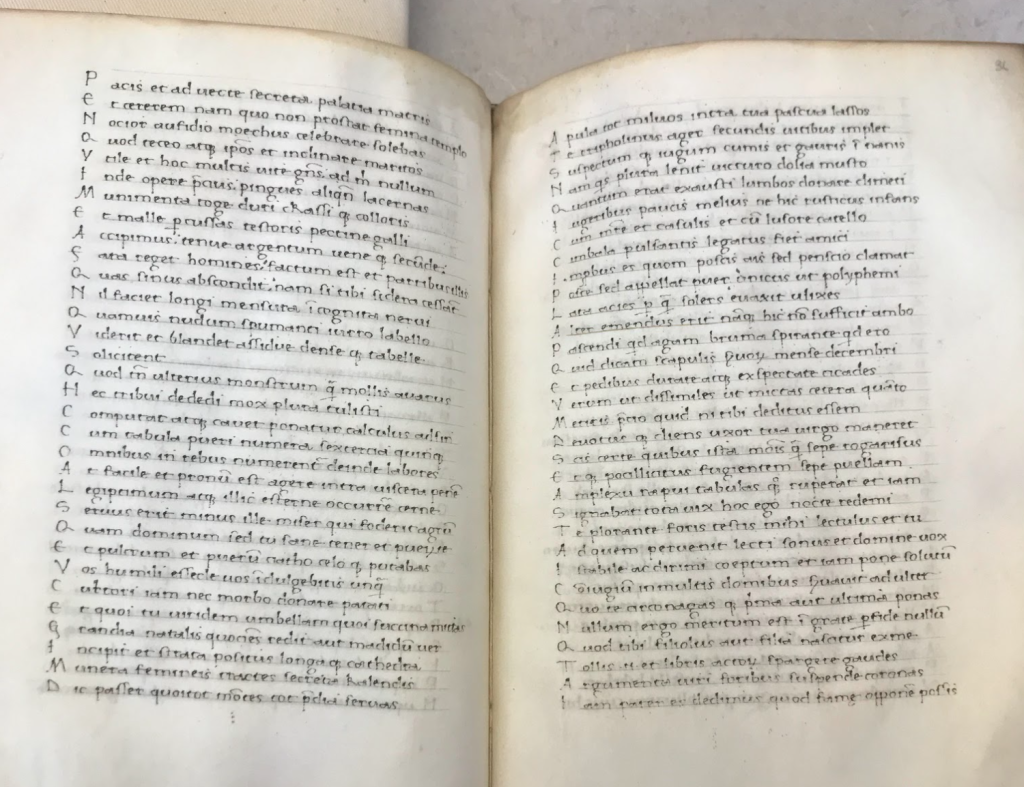The Juvenal manuscript from the Les Enluminures collection is a bit of an outlier, both in its historical context and in the condition we found it in. No, it wasn’t the wear and tear expected of a late 15th century manuscript or even the doodles.

Key elements were missing. Blank squares stood in for initials that were never filled. Though we saw rubrication, it wasn’t consistent and didn’t extend all the way through. It contained all of Juvenal’s Satires and Guarino da Verona’s commentaries, but that was only after a second, less competent scribe had completed it. The first scribe had dropped off for some reason. Something had gone awry, cutting this manuscript’s commission process short.


Juvenal the Roman satirical poet and Guarino the Italian humanist instructor certainly have insights worth pondering but first comes the obvious question: why was this manuscript never completed?
The simplest explanation for why the manuscript’s production halted is that the source of funding stopped. If we knew who the manuscript’s patron was, perhaps we could get a reason as to why. Unfortunately, the name was completely erased from the ownership note. No clean, easy answer then, but the “Est mihi” [is mine] on that note indicates it belonged to an individual (Les Enluminures). Manuscripts weren’t cheap. This patron had money. So what was going on in the life of a wealthy person in the Italian city states during the late 15th century? Even not knowing the identity of the patron, pursuing that profile could at least give us some plausible answers.
The Renaissance in Context
The Italian Renaissance is often seen in popular imagination as an illustrious period full of art and innovation that marked a turning away from the Middle Ages. People think of geniuses like Michelangelo, DaVinci, or Petrarch if we’re going earlier (we will). The rise of Studia Humanitatis (Baker 236), or Italian Humanism as it’s known today, was the prevalent movement responsible for this shift and subsequent output in great works. The ideal to attain was eloquence in Latin and Greek (and Juvenal, a Roman poet, was one of many classical writers whose works underwent a resurgence due to this renewed interest). The humanist movement’s adherence to Latin and Greek form illustrates how humanists were hyper-aware of the image of their movement. In their revival of the classics, they wanted to bring about and define a new golden age, crafting an idealized portrayal that carries over into our rosy perception of this period today.
But then what was the reality of the Renaissance around the time of the manuscript’s commission? Turns out it could be pretty rough.
Despite its aesthetic, the Renaissance was by no means peaceful even for the wealthy. Corruption was widespread throughout the Italian city states as families and sycophants tried to consolidate power and wealth, often through violence. The Pazzi Conspiracy in 1478 is one such example. Lorenzo Medici was one of the Renaissance’s greatest patrons, but he was able to support so many artists in part through money pulled from the state dowry fund. That combined with other offenses against the other oligarchal families spurred an attempt “not simply to overthrow… but to murder” the Medicis (Bartlett 63). Lorenzo survived the assassination attempt but his brother died. If our unknown patron was an oligarch, perhaps he fell to similar machinations.
And remember the Black Death? That’s still around! Ada Palmer, who specializes in this period, has never read a full set of letters that doesn’t have some mention of the plague (Black Death, COVID…). It was still a very real, very deadly threat with the highest mortality rates in cities. That doesn’t bode well if our patron was among the “sophisticated urban” readership eager to collect books during this period (Pettegree 9, 50).
Given that, it’s easy to imagine the Juvenal manuscript’s patron was a casualty of political bloodshed or suddenly caught the plague. In both cases, if the patron dies soon after starting the commission, they wouldn’t be around to pay at the later stages and the manuscript wouldn’t have been finished. Admittedly, it’s not likely but it’s fun, isn’t it? I do have another more plausible explanation though.

The Rise of the Italian Printing Industry
The Italian printing industry rapidly grew from the 1470’s onwards, eventually outputting a third of all European books in the fifteenth century. Beginning first with Venice in 1469, twenty-four Italian cities had a functioning press by 1473 (Pettegree 49). Among the wave of books being printed was, you guessed it, editions of Juvenal’s Satires. A Second Aldine edition (1515) can be found in our very own Hargrett Library! This Aldine edition wasn’t the first printed Juvenal either. Here are printed Juvenal editions dating back to the 1460’s! These would have been circulating at the same time that this manuscript was commissioned, though notably none had Guarino’s commentaries like our patron specified.
Although prices varied based on the context, printed books cost less than manuscripts of the same text once embellishments were left out (Nuovo 335). To the patron, it would be something like opting for the digital version of a book on Kindle rather than buying a fresh hardcover edition. Instead of saving just 10 to 15 dollars though, these wealthy buyers could be saving a small fortune.
This is especially true for our patron’s acquisition of a Juvenal. The Italian printing industry was still experiencing its growing pains in the 1470’s. Printers had overestimated the demand and the market was “glutted with editions of classical texts, including multiple editions of works for which there were simply, as yet, insufficient readers.” This bulk of unsold classics included five editions of Juvenal (Pettegree 51). Such market conditions with an increased supply likely would’ve resulted in sellers lowering the prices of these printed editions (Nuovo 339). Perhaps the patron happened upon a printed edition of Juvenal so cheap they were willing to forgo Guarino’s commentaries. It can be hard to say no to a good deal!
Aside from missing Guarino’s commentaries, there would’ve been little friction against this decision. Differences in formatting between manuscripts and printed versions was intentionally minimized as the Italian printing format drew directly from regional manuscript conventions (Feld 341). This can be seen in Figure 5, where the printers reserve space for an initial and follow the same single column format. Surprisingly, most buyers didn’t seem to have much of a stigma against this new printed form either. They didn’t mind too much “whether their book was a manuscript or printed, so long as they obtained the desired text” (Pettegree 16).
What May Be…
So maybe the patron died suddenly, or maybe the patron was feeling especially thrifty. There’s still a lot of maybe’s in the end. I hadn’t expected to be able to uncover a definitive reason for why this Juvenal was never completed, but the pursuit of these possibilities has led me to so many interesting details that have reshaped how I view the Italian Renaissance. Maybe that happened here for you as well?
Works Cited
Bartlett, Kenneth R., and Gillian C. Bartlett. The Renaissance in Italy : A History. Hackett Publishing Company, Inc., 2019.
Baker, Patrick. Italian Renaissance Humanism in the Mirror. Cambridge University Press, 2015.
Feld, M. D. “A Theory of the Early Italian Printing Firm: Part I: Variants of Humanism.” Harvard Library Bulletin, vol. 33, no. 4, Oct. 1985, pp. 341–77.
Juvenal., et al. Iuuenalis ; Persius. [Second Aldine edition.]., In Aedibus Aldi, Et Andreae Soceri, 1515.
Les Enluminures, MS TM 942. https://www.textmanuscripts.com/medieval/juvenal-satires-127694?subject=humanism&inventorySearch=0&p=8
Nuovo, Angela. The Book Trade in the Italian Renaissance : Book Trade in the Italian Renaissance, BRILL, 2013.
Palmer, Ada. Black Death, COVID, and Why We Keep Telling the Myth of a Renaissance Golden Age and Bad Middle Ages –, 4 June 2020, https://www.exurbe.com/black-death-covid-and-why-we-keep-telling-the-myth-of-a-renaissance-golden-age-and-bad-middle-ages/.
Pettegree, Andrew. The Book in the Renaissance, Yale University Press, 2010.
Shaw, David. Editions of Juvenal to 1600, http://docs.bibsoc.org.uk/juvenal/juvenal_main_list.htm.
